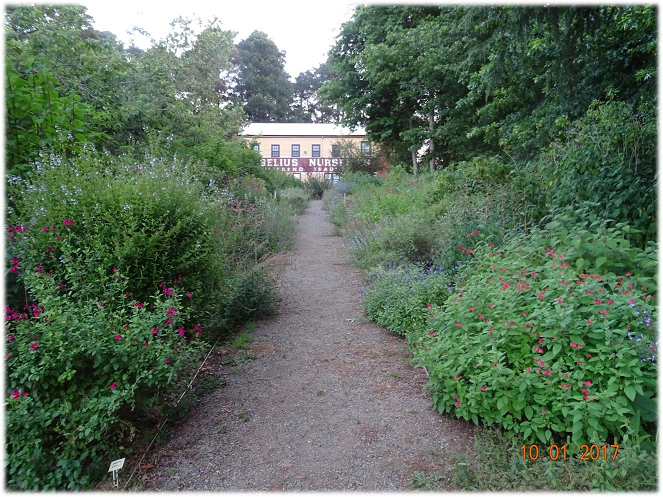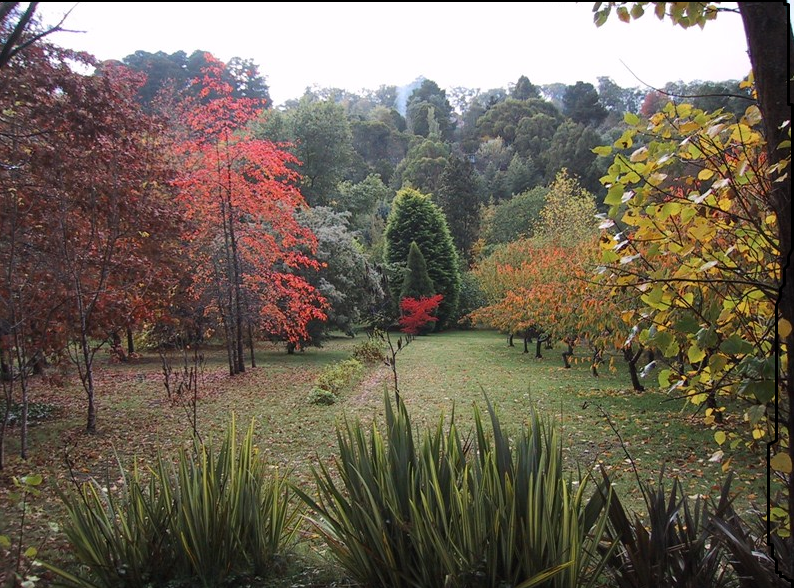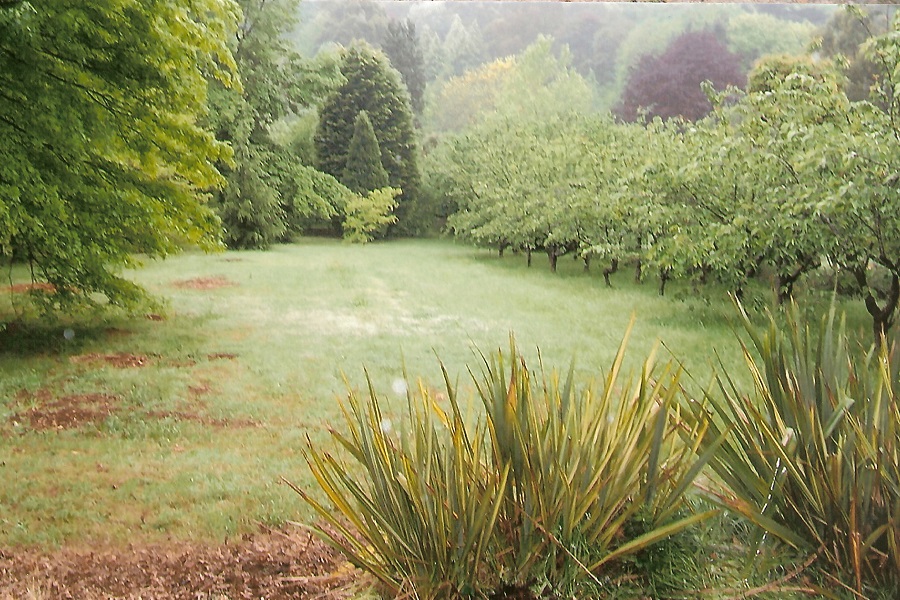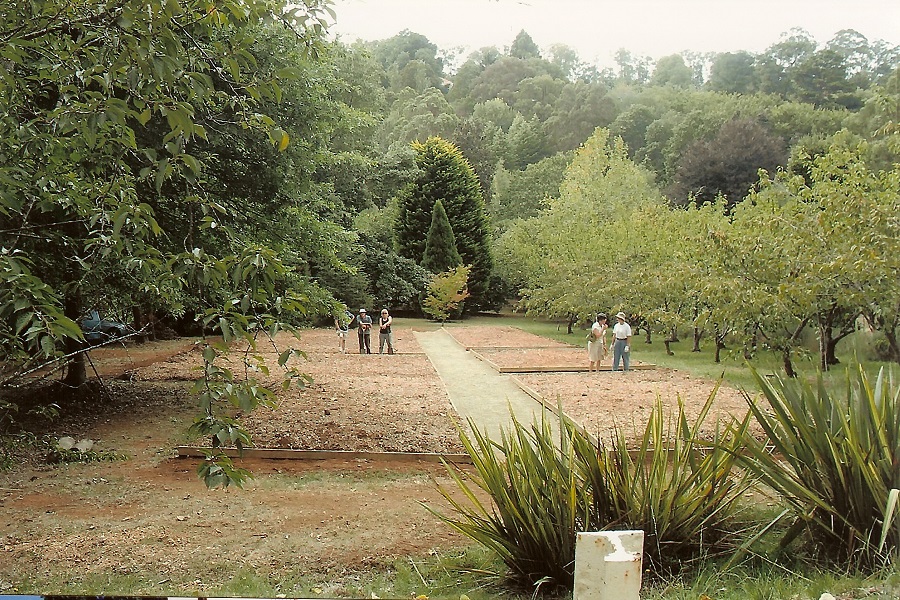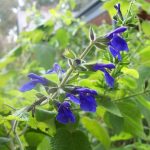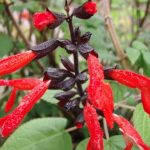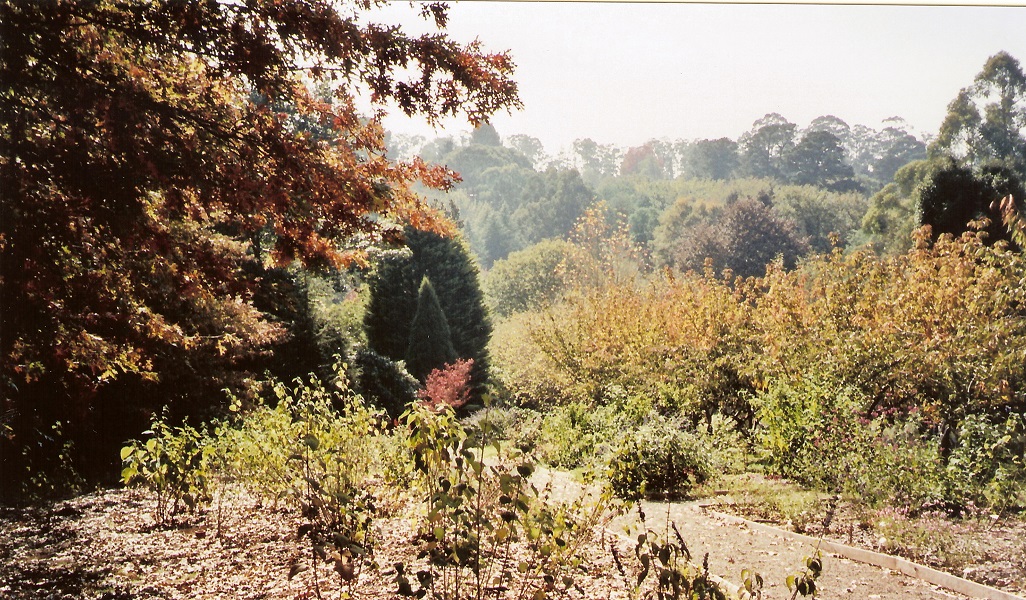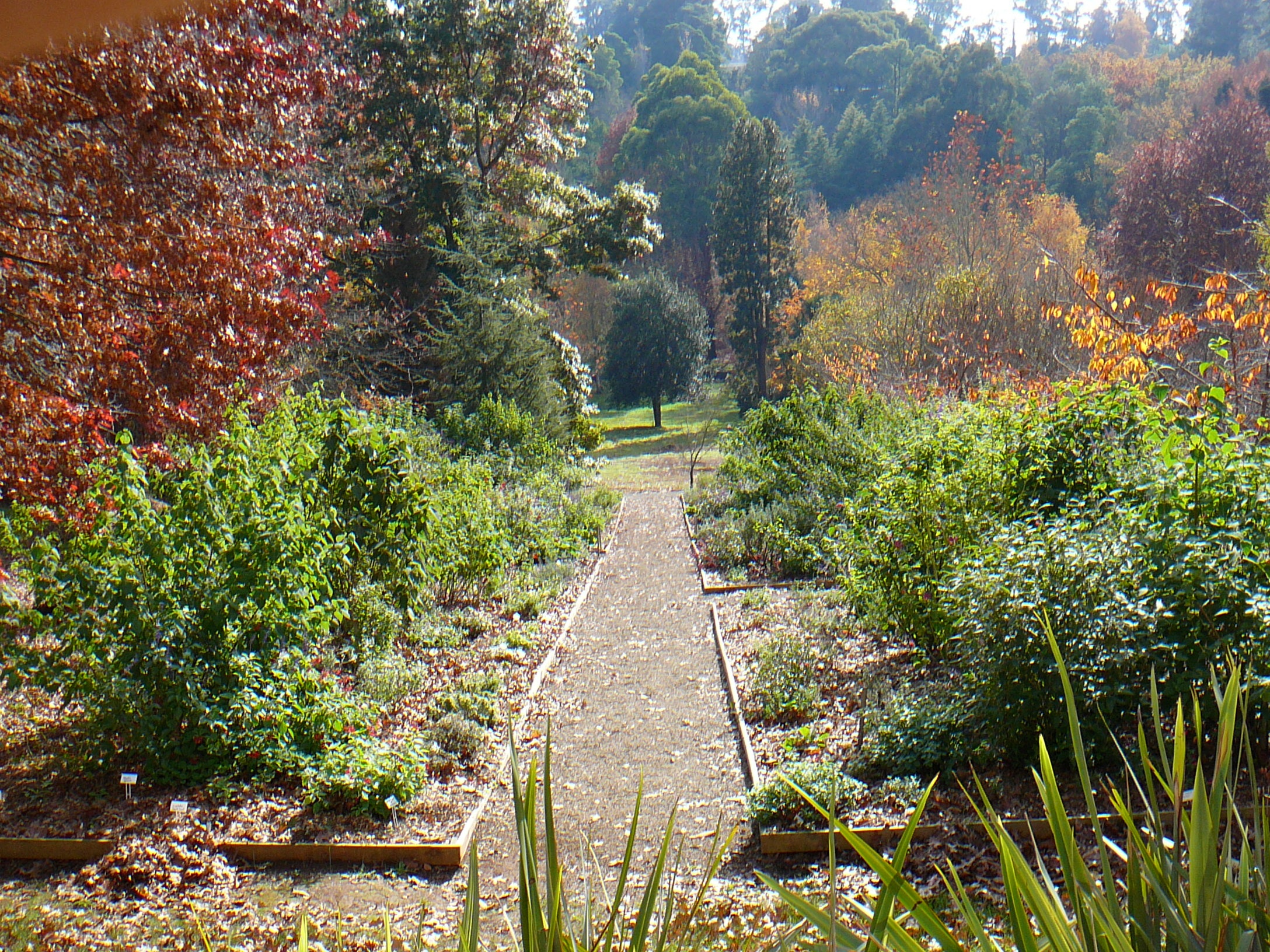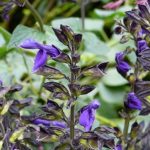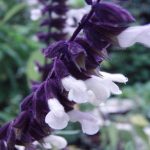 Nobelius Display Garden
Nobelius Display Garden
For those who don’t know where or what Nobelius is: our Display Garden is part of Nobelius Heritage Park, on the old Nobelius Nursery site. This wonderful site is situated in Emerald, near the Emerald Lake, underneath the Nobelius Packing Shed Ave on the Puffing Billy Railway Line.
In the beginning
Before we began at this present site, we had a lovely small plot just below the Emerald Museum. This was the initial Study plot to gauge how the various Salvias grew under these conditions. This area was chosen by Ray Boatman ( the instigator of the Study group) with the help of Russ Gyberg, the curator of the Museum. It wasn’t long before we outgrew this small plot.
 The original Salvia garden below the Museum
The original Salvia garden below the Museum
The present display garden was the result of the Group having too many Salvias and not enough room to display them properly to their best advantage. So the hunt was on to find a more suitable location. This was found in Sept 2006 with the help of the Management of Nobelius who are the custodians of the Heritage Park and the Shire Council who allocated another plot for us to develop. A fantastic area was found underneath the Packing Shed, which was under utilized. It was perfect for our purpose, it has a gentle downward slope towards Emerald Lake and Puffing Billy going past at the top, it is an open area free from trees and their roots, bordered by Flowering Cherries on one side and Pin Oaks on the other, all in all an area of approx. 40m x 14m, perfect for the growing of Salvias.
Selecting the area began in 2007. Before the end of the year, we had the area rotary hoed 3 times, ready for the loads of compost and mulch that were dumped, waiting to be spread and raked. Most of the hard work began in Feb 2007 ( it was the beginning of hot dry horrible summers if you’ll remember), but with a great band of helpers we laid out the beds, these being in the form of a central path and a number of paths going off to the sides. Our band of helpers then raked Richie Nottage compost and the chipped mulch for the top. When the internal edging had been completed and the Coldstream toppings had been laid, the garden beds looked wonderful, just waiting to be planted.
NOBELIUS DISPLAY GARDEN
Memories of a person visiting Nobelius
involucrata spp ‘Pink Icicles’ ‘Timboon’
My first real visit was on a sunny warm afternoon after a series of sunny warm dry days and just before a run of very hot weather. I knew the salvias hadn’t been watered since planting and there had been little rain. The plot is orientated North South down a slope and is overlooked by the Puffing Billy Shed. People passing by were very warm in praise of the garden and I was just amazed at its beauty. It reminds me of an embroidered silk carpet. It is rather formal and skillfully planted. I saw it as a whole work of art and then began to see the individual treasures that made it so and began to realize what talented people created it. We are so lucky to be a group that is not only hard working but so creative. This garden is a reference ‘book’ to demonstrate salvias; not only their worth as beauty in the garden but their growth habits and the hardiness of individual forms and colour wise ‘what goes with what’.
‘Costa Rican Blue’ mexicana ‘Limelight’ urica ‘Blue ribbon’
The background of the Eastern border is tall old flowering cherry trees and the Western border has a background of oak trees. Tall strong big leafed salvias are planted at the back of the borders. Old plants shifted from the original garden were thriving. Seeing a large garden planted with Salvia plants from all over the world is such a unique opportunity for study.
Trudi Fry
gesneriiflora ‘Tequila’ adenophora gesneriiflora spp
Planting at Nobelius
There have been progress reports on the various plantings at the new Nobelius garden starting in early April 2007, June 2007 and again in Nov 2007, then in April 2008 and a further planting in winter of 2008, in the rain!! Other than on these planting days, there has been no watering. So what is the key to the success?
‘African Sky’ murii ‘Marine Blue’
At each planting, Jillian has come along with huge tubs of pre-soaked water crystals (as well as all the other paraphernalia. I don’t know if people realise just how much these activities and the propagation of plants for sale depend on Jillian and Lyndi). A scoop of these has been placed in each well-watered hole prior to planting, and each plant has been well watered before and after planting. And that’s it.
There is plenty of debate about the effectiveness of water crystals but this speaks for itself – together with the deep mountain soil and the local climate at Nobelius. It is certainly a contrast to the thin soil and hot, dry conditions here in Warrandyte.
Pat Anderson
 The first plantings Autumn 2008
The first plantings Autumn 2008
NOBELIUS SAGA
What a wonderful sight met us when we went up for our first Working Bee at Nobelius in late April (2008), so many Salvias were either coming in to bloom or were in full bloom. Although the heat and the long dry delayed and deterred us, it certainly didn’t stop the Salvias from flourishing in this great location.
There were remarkably few loses and a little storm damage, with plants blown over and some almost out of the ground. This was the scene that met Bevan when he went to spray’ The Oxalis’ the week before we went up. But thanks to the great turn out of helpers, it was a case of ‘so many hands make light work’ and in no time many of the blown over plants were neatly tied, pruned and staked, and those not helping with digging holes and planting the lower red bed, were doing some of the other many tasks that always need doing.
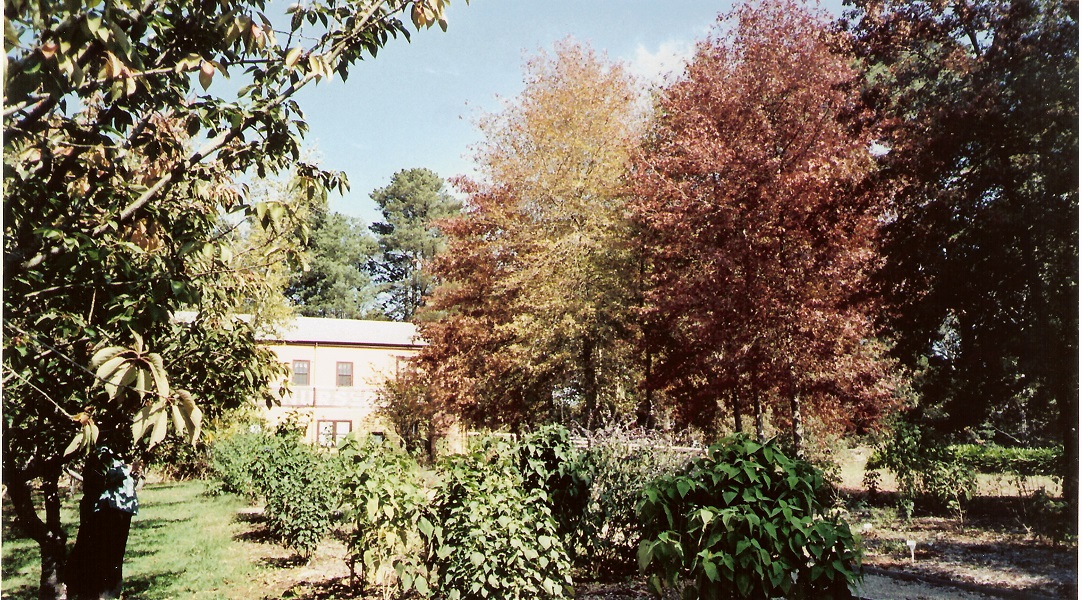 The first plantings Autumn 2008
The first plantings Autumn 2008
My thanks to Jennifer and Geoff Ellis, Pat Jenson and John Thom, of course myself and Jillian and a few new comers – Meridith Taylor and Debbie Capozzi, and to Bevan for coming up from Sommerville to spray the weeds, so thankyou everyone.
Because we had such a good turn up, it wasn’t long before the planting, watering and other tasks were completed, and we could retire and relax under the Oaks for another of our renowned sumptuous feasts, everyone brought a plate of delicious food, including Jennifer’s ‘shushi’, tea, coffee and water, reclining on rugs in the shade with good company after a couple of hours of hard toil, what else does a person want. With all that completed, we were able to go home nice and early after a good day’s work.
What ‘s left to be done? We still have to constantly prune, to keep many of the smaller plants compact, not allowing them to get too leggy. There is still more spraying of Oxalis to be done. The lower pink bed is the next to be planted and as many of the small plants from the old site have to be relocated, some will be planted, others may be able to be broken up and potted on. All these tasks can be achieved at our next Working Bee in June . So bring a spade, snips, knee pads, plastic bags, a hat or coat and a plate to share and we can all get on with what has to happen. Then most of the hard work would have been completed and everyone can enjoy the spectacular flowering of our Display Garden.
NOBELIUS SAGA CONTINUED
2009 arrived with very little happening due to the horrible hot weather, we weren’t going to ask anyone to try and work in that heat. When we did venture up to inspect the condition of the garden, we were pleasantly surprised at how well the plants had stood up to all that hot dry weather and had come through with flying colours, especially as no extra water had been applied.. We didn’t loose any plants at all, thanks to a wonderful location, the soil, the microclimate, protection from the tall trees and of course the preparation when planting. Although most of the leaves had dropped from the big leaved Salvias, leaving only sticks, they were not dead, these were pruned down to a good bud, or left if they were showing signs of coming into flower, all unsightly, fallen stems were pruned.
So many of the Salvia greggii’s and microphylla’s were still in full bloom, the hot weather hadn’t fazed at all.
All the beds are being systematically pruned now it’s autumn, March/ April 09,all flowers being removed, the smaller Salvias being pruned down to a good leafy bud, to encourage compact growth before the cold weather sets in. The larger Salvias are being pruned for shape and dead wood being removed. Any late flowering Salvias are pruned down for a good shape.
With the little rain that we have had, it has been amazing how the Salvias have sprung back to life again. The big ones are either beginning to flower or are in full bud, many of the smaller Salvias that had been pruned at the beginning are flourishing and beginning to flower again.
This autumn and winter will be a wonderful sight from Puffing Billy with a riot of colour in our Display Garden.
- Judt Forrester 2009
- David Bailey 2009
- Pat Jenson 2009
We are continually planting those bare spaces, pruning and mulching, when most of the hard work is completed, the Group plans to hold an open day in November in the Packing shed, where you can view the whole garden. We hope you will join us on that wonderful occasion.
‘Pumpkin’ x jamensis Yellow ‘La Luna’
More of the Nobelius Saga
The new year opened up to be bright, sunny and full of promise after all the work that was put in to get it ready for the open day, November 09.
Of course when coming back to the garden, there is a mountain of work to be done, such as pruning and weeding. In fact that’s all we seem to have been doing all year is pruning and the weeds were surprisingly few as compared to previous years.
Well as we all know, we have had lots and lots of rain!!! and most Salvias have benefited from that soaking rain that has allowed them to burst forth into leaf and flowers, and of course with all that growth , all the Salvias have to be pruned down to make each plant sustainable.
Autumn saw us start the winter pruning of the small Salvias, ( pruning back to good buds), to get them to put on new compact growth before the cold winter winds come – for most we were successful.
The Autumn flowering began with S. mexicana ‘Limelight’, involucrata (tall), ‘Pink Icicles’, ‘Romantic Rose’ and many other beautiful Autumn/ Winter flowering Salvias to follow.
The Winter unfortunately proved to be very cold and was too cold for some. We found that quite a few large leaf Salvias lost their leaves and became dormant, amongst others were ‘Black Knight’, the mexicana varieties, tubiflora, ’Purple Majesty’, ‘Violet Eyes’. These we didn’t touch at all, they were just a bunch of dead sticks standing there looking very unsightly – we were tempted many times to take them down, but we just bit our lips and left them. Most of these either didn’t come back again or took along time to put out new shoots.
‘Black knight’ ‘Purple Majesty’ ‘Violet Eyes’
It may be that these varieties may have to be replace regularly every 2 yrs, or they may need to be more sheltered by other plants around them. The other disappointing plants were “ Costa Rican Blue’ and ‘Omaha Gold’, they just haven’t got going up there in
that microclimate – we only have 1 good plant of ‘Costa Rican Blue’, the others are slow, sickly, so we have planted better plants beside them, hoping that they put on good new growth, especially with all that rain we’ve just had.
‘Costa Rican Blue’ mexicana ‘Lime light’ ‘Omaha Gold’
This rain has given some Salvias that were on their death bed (due to a lack of water) a new breath of life, they are producing new leaf growth and copious amounts of flowers.
I’m please to note that most if not all the herbaceous Salvias have come up and responded to all this moisture with great growth and good flower stems. Unfortunately when we were putting in our beautiful new labels, many of the old labels were pulled out, without a little push in label next to the plant, so that when we took out all the labels, we didn’t know what some of the Salvias were – it has taken a lot of investigating to correctly identify some of those herbaceous Salvias. By getting Lambley Nursery to send a few photo’s and descriptions over, we have been able to find out what we do have and what we don’t have.
The oxalis has been rampant this year as we haven’t had the people power to help spread mulch thickly enough to stop the Oxalis from coming up, so next year we will spend a lot of time proximity to the plants getting rid of those oxalis bulbs. I know that we could spray or use a few remedies, but when the oxalis is coming up in the middle or very close to the plant that you don’t want to take chances, but rather hand weed around the problem.
The Official Opening of Salvia Display Garden at Nobelius Heritage Park. 2009
Any visitor to the Opening of the Salvia Display Garden would be able to sense the
excitement in the air when arriving at the Nobelius Display Garden on Sunday 15th November 2009
The garden beds were overflowing with flowering plants. Where else would we be able to see such a comprehensive display of a collection of Salvias in prime condition? We are indebted to all those who have worked over the past two years to establish and bring this garden to its peak under the guidance of Lyndi and Jillian.
The setting was perfect. The weather was ideal. It was a lovely experience for visitors as they arrived, walking up the gravel road into the Nobelius Heritage Park across the grass and into the shade of glorious trees. Then out into the sunshine to see the display beds of Salvias in flower and in the background the old golden- painted timber Nobelius Packing Shed.
Under the trees, green covered tables were set out packed with the best selection of Salvias anyone could imagine for sale. Many visitors came to the tables with prepared lists of Salvias to purchase and to add to their collections; others were directed to the beds of Salvias in the Display Garden to select from the variety of flowering plants large and small all clearly named with excellent labels…
Refreshments were available throughout the day in the Packing Shed. Tables were set with bowls of flowers including salvias inside and out on the railway platform where visitors could sit, eat, chat and wave to the passengers on the passing Puffing Billy trains.
Award winning garden writer, Penny Woodward, was invited to open this Salvia Display Garden and her address in praise of our project and of Salvias is printed elsewhere in this edition of Salvia News.
In her introduction Lyndi thanked the many people and groups who had worked so hard towards the success of the day.
Margaret Keir
‘Crimson & Black’ greggii ‘Coral’ ‘Mystique’
Nobelius Saga 2010
2010 dawned bright and clear for Nobelius. Going up in February saw the garden dry but in a much better condition than it was last year at the same time. This year the weather has definitely been kinder with a little more moisture over those hot months.
It wasn’t long before Jillian and I began our Wednesday visits to begin cleaning up. Most plants survived quite well but there were a few that didn’t make the mark or were struggling, namely S. fruiticosa ( an old bush that was gradually giving up and didn’t like the humidity that often occurs in that area) other causalities were S. sclarea alba and S. canariensis candissima, which put on such a splendid show during the open day that everyone wanted them, and a few other mealy plants that hadn’t grown well .
As with all new gardens there is a huge learning curve to learn about the plant that are going in, and as always there are a lot of ups and downs which is showing us that we can’t expect plants to go living for ever, that some have a relatively short life span and they need to be renewed every two years at least, others look best if planted annually although they may be a perennial.
Looking around the garden showed some plants needed shifting, either they had grown too large and had over powered other Salvias or they just didn’t fit into that niche.
What we did find was, horrors of all horrors was that we had planted a big Red Salvia in the Pink bed!!!. So in due coarse, this will have to be taken out and be replaced with perhaps a blue Salvia – no confusion there.
The first Garden Day in April had a wonderful turn out . Each time we have a Garden Day a few new faces appear who are willing helpers and get stuck into the jobs that need to be done. This is encouraging as it shows that website is working and these new faces want to know what we’re doing in the Salvia Garden at Nobelius and be part of it.
Even Old Bill (94) and Des came up recently from Geelong to help prune the masses of Salvias yet to be dealt with. Bill came with his secateurs ready willing and very able, so I put him to work at dead heading and getting rid of dead wood, which he did very well.
Once all the major pruning is complete, planting will begin again – shifting those plants that don’t belong, to a better position, filling in gaps and planting new species, coupled with this is the job of fertilizing each bed, probably using “blood n bone” and “Rooster Booster”, then finally put on all those lovely oak leaves that we have at our disposal as mulch, they will keep the soil moist when it warms up as well as smothering a lot of oxalis.
Being the middle of winter, Nobelius looks wonderful, a kaleidoscope of winter colour from the large Salvias, these will continue flowering throughout winter and well into spring, when the smaller Salvias will take over the main display.
The garden is well worth a visit at this time of year.
Nobelius 2011

What a difference a little rain makes, it’s been amazing, so many Salvias that were really struggling over the last few years during that dry period, have really blossomed, putting on good new growth and flowers, Salvias we thought we were going to loose included S. greggii ‘Coral’, ‘Purple Majesty’, ‘Violet Eyes’, some ‘Black Knights’ and few others.
- ‘Black knight’
- ‘Purple Majesty’
- ‘Violet Eyes’
Now we have the problem of getting through the cold damp/ wet winters. Some like the mexicana Salvias don’t appreciate the long cold periods so have to be replanted every few years. I think that may be the same for ‘Black Knight’, as it took a long time to come back after last winter.
Because of all the rain we’ve had, the large leaved Salvias in the Pink bed that Jillian pruned down have gone crazy, really reaching for the sky. ‘Romantic Rose’ has grown taller than the Cherry trees up to 4-5m H.I hope the winds don’t come and ruin them too much.
Jillian and I have been going up most Wednesdays and just pruning. Jillian the larger Salvias and I prune the small Salvias in the front, as I can bend down a little easier. It’s constant. As soon as we’ve finished one bed, we have to start all over again!!
The storms of late Feb / March wrought a lot of damage to our path, leaving large rills all the way down the path.
We’ve since had a load of toppings delivered with a little cement dust incorporated which will help it to last longer. Patrick very bravely volunteered to tamper it all down. He did a magnificent job, the path looks great and so very clean, Thankyou Patrick.
Rain and storm damage Feb 2011
During the Autumn months, Nobelius was looking magnificent, with all the Autumn/ winter flowering Salvias in full flower. With the sun shining, the little Eastern Spinebill flitting through the Salvias, the garden really was beautiful and those people walking through were amazed at the variety of Salvias and how tall some of them grew.
Now the dreary winter months are here, the garden is looking a bit ordinary, the winds have played havoc with all the tall Salvias, so Jillian is having to prune them right down, even though some are still flowering – don’t worry, there are plenty of others waiting to burst into flower. When one Salvia finishes, another takes it’s place, so you have some things flowering all times of the year.
With the effort of a few volunteers to prune and stake, cultivate around each plant, fertilize and mulch each bed, it won’t be long before the garden is in full flower and breathtaking again.
We are at that stage where we can start taking out some of the Salvias we duplicated to fill in spaces and begin planting others that have recently come on to the scene.
It’s always a struggle to place the right Salvia in the right position for it to flourish and not be over bearing to the next plant.
Some Salvias have really taken advantage of that rain and decided to spread their wings and go walk about!. We’ve had to hack back such Salvias as S. elegans ( Pineapple Sage) , S.’Honeymelon’, corrugata, chamaelagnea and remove pups from S.gesneriiflora and ‘Red Rambler’.
There is always plenty of cutting material at the end of the day for those who come up and help.
We hope to do a lot of planting in the next few months of some of the new salvias that have come our way.
Many Garden Clubs have been visiting Nobelius as a Day out for the club. We’ve been able to help them identify those Salvias they have in their own gardens.
With a few more working B’s , the garden should be looking good in preparation for our annual Salvia Day in late November.
Nobelius 2012
The summer of 2012 was a good year, with the normal high temperatures, but also brought a certain amount of rain which really helped things grow, so when we came back from all our holidays, we were greeted with masses and masses of growth which had to be cut back off the path – people had to be able to walk down the path easily without being accosted by Salvias, reaching out to grab them.
We were privileged to have our Editor Beth Clisby join us at our first working bee.As she is wheel chair bound, and determined to help, Beth was happy weeded and cutting back from sitting on the ground. It was a wonderful happy day with Beth and others to help.
Working bees continued to cut back and try and find places to plant new Salvias. All the beds were filling up fast.
By May we thought we should put another load of compost on the beds, so 8m of Compost from Richie Nottage was delivered and spread with the help of a good team of dedicated workers. It only took us 2 hours to spread the load after the small Dingo dumped small heaps all the way down the path.
We had to make sure all areas were covered and the small herbaceous salvias were unearthed and could be seen. With a new load of compost and the next couple of heavy showers, all the plants really started to take off, especially in the Spring with the warmer weather arrived.
Of course with this new load of compost, when spread thickly, it suppresses all the Oxalis. We were fortunate that we didn’t have problem from any oxalis for another year.
Nobelius 2013
After the storms in 2011 that left their mark on the main path and the ravages of time,wear and tear, it seemed that the timber edging was falling to pieces and needed replacing.
Reinforced Aluminum edging seemed the way to go. A working bee was organised and a wonderful turnout of willing helpers came to help install this new edging. Some dug trenches, others banged in pins, we all made sure the edging was straight as it was very flexible and then cleaned up. It all looked very smart and we were very pleased with ourselves after a good days work.
We also noticed after the edging was complete that the beds really needed some goodness put into the soil, so it was time to apply Richie Nottage compost again, so again word went out for help and help we got. Tarps were laid down the path, small deposits of compost were dumped and then the shovels and spades got busy distributing the compost in and around the plants.
Again another good day’s work was had. Everyone stopped , had a cup of tea and went home exhausted.
This was also the year we began having “Salvias at Nobelius.” Our Annual sale of Salvias.
Although this began as quite a small sale of plants, it will continue to build as more people know about the event.
Salvias at Nobelius 2013
Nobelius 2014
2014 was an normal year with the small group of dedicated volunteers continuing to clean out beds, clean up plants, cut back off the paths and when new plants became available, find a space that could accommodate these new plants.
Nobelius 2015
This was a very interesting year when we had Salvia thieves.
When we came back in the new year, realised that someone had been enjoying themselves by taking loads of cuttings from ‘Snowhills’, Blue Hills’ and ‘Caradonna’. They would cut down half the bush and leave the other half standing!!
Then we found plants missing and the labels still there!! so they hadn’t a clue what plant they had or the plant and the label were taken and the stand left.
On numerous occasions newly planted Salvias were taken or anything that was in flower was taken, even old established plants were half dug up, others were found dumped behind other bushes or in plastic bags – hoping to come back later to pick up.
It was suspected that someone thought that our garden was in a public park, so they could help themselves, that they didn’t have a garden of their own, so they thought they would take our flowering plants – possibly thought that he/ they would surprise their mum with some pretty flowers in the garden!!
To combat these thieves, we put up signs throughout the garden, warning them that the gardens were visited by the police, that there a surveillance camera ( which Patrick was very clever in being able to install on the wall of the packing shed. We asked those who regularly walked through the gardens to report any strange behavior happening. We asked people not to take cuttings or plants from the Garden.
The signs and the camera must have had the desired effect as by the end of the year and into the new year, we didn’t have any more trouble with plant thieves.
It seemed it was time to reapply compost to the beds once again. We organised some more Ritchie Nottage compost to be delivered, the little Dingo was ready to go and so was a team of enthusiasts ready to spread the compost in between, over the top and underneath all those Salvias. Tarps were laid down and small heaps were deposited all the way up and down the path. With all the volunteers,they make short work with the task, it wasn’t long before all the 8m of Compost was spread.
March 2016
Luckily 2016 proved to be relatively uneventful. The thieves seemed to have gone, we had good rain during the year, which resulted in some really good leaf growth and a wonderful display of flowers.
Maintenance seemed to continue as usual
Nobelius 2017
This year we really started to clean out the shrubs on the pink side, really chopping them back, pulling out old ,weak or disfigured plants. Once cleaned out and pruned, beds weeded, then Rooster Booster was applied around the base of plants and SugarCane Mulch was applied thickly all over.
By the time we had removed all the leaves and each section was cleared and fertilised and mulched, it took most of the year to complete.
What a difference the fertilizer and Sugar Cane mulch made to the soil. The Sugar Cane seemed to bring up and create more worms. With their continuous work, the soil became more friable and able to retain more moisture not only in and around each plant, but all those spaces between the plants that used to become compacted, especially with us walking over the soil – with mulch, those areas were not compacted.
With the pink side finally completed, it was time to tackle the red side that hadn’t had much attention for at least 2 years.
This would be seriously tackled in the new year.
Summer in Nobelius 2018
Summer in Nobelius was a very prolonged hot and dry season, without much moisture during the summer months, nor even the autumn months.
Don’t forget we DON’T WATER these plants, the Salvias have to survive, and survive they did. We didn’t loose any plants except a few young newly planted Salvias at the end of 2017.
As the dry continued, the big leaf Salvias began to look bedraggled and forlorn with their leaves just hanging, looking a bit yellow. Interesting enough , most plants still held their leaves, not dropping them as in previous dry years.
It was worthwhile walking throug the garden to see how the plants were coping and what was actually still growing and flowering. These weather conditions showed what could cope with the heat and the dry and what could not. It was the Sth African and Mediterranean Salvias that coped very well, still standing upright and green, some even beginning to flower. Many of the small greggii and microphylla ‘s were still flowering beautifully presenting a cheery face for those walking through the garden.
I think many of the larger leaf Salvias coped by the shelter given by the Pin Oaks and the Flowering Cherries on either side of the garden from the blazing sun and the heat from the north/ westerlies that come up the slope. Their leaves were already dropping to covering the ground and helping to keep the ground cooler for their roots.
Most gardens always look hot and dry when the sun is blazing, and it’s 25C+, but when you have lots of small Salvias flowering, the garden look so much better, and the situation doesn’t seem so dire!
Autumn 2018
April opens our first Working Bee for the year. This year has been so dry. Although Jillian and I continue to prune and clean out throughout March and early April, we couldn’t plant until we received some decent rain.
By the time late April arrived, we had received rain or at least a decent downpour to relieve all those panting and gasping Salvias.
 We saw a nice gathering of helpers for our first Working Bee for the year, which is always encouraging. What a difference a few more hands made, it was wonderful what was achieved.
We saw a nice gathering of helpers for our first Working Bee for the year, which is always encouraging. What a difference a few more hands made, it was wonderful what was achieved.
All the S.gesneriflora’s were slashed right down to 2 nodes, so that the whole area looks quite bare, the S. aurita var galpinnii was also slashed down, which hadn’t been touched for a number of years, the edges of S. forskaolhi were neatened.
 Other small plants on both sides of the path were trimmed and neatened, others that had not been touched for years were pruned back to new growth, dead and weak stems were removed, the whole plant tidied and old leaves around the bases removed as these can cause rotting in a wet year ( although in this case those leaves acted as a mulch, helping to keep the roots cool .)
Other small plants on both sides of the path were trimmed and neatened, others that had not been touched for years were pruned back to new growth, dead and weak stems were removed, the whole plant tidied and old leaves around the bases removed as these can cause rotting in a wet year ( although in this case those leaves acted as a mulch, helping to keep the roots cool .)
After one area was pruned and cleaned out, then a generous handful of fertiliser (Rooster Booster) was given to each plant and the area mulched with Sugar Cane mulch, which we find is easy to spread and doesn’t blow away. Of course the area was a bit smelly for a few days, but that soon disappeared. The mulch acts covers the soil, provides a cool root area, provides a cushions in areas that are walked upon without compacting the soil. This mulch will retain any moisture it receives which begins to encourage more worms, which of course helps to break up the soil, making it more friable when having to plant.
The Pink side was well mulched and fertilised last year and the results have clearly shown to be beneficial with some really good growth on plants that may have been small, sickly or spindly before. It shows that all the Salvias on that that side look really healthy.
At least by the end of the day you could see where we had been, except you couldn’t see the plants as so many leaves had fallen. We had no idea where the S. forskaolhi edge was nor the patch of S. aurita var galpinnii – we assumed it was at the top of the bed, but??
We all went home feeling we had at last achieved something. In this case, ” Many hands make light work”

